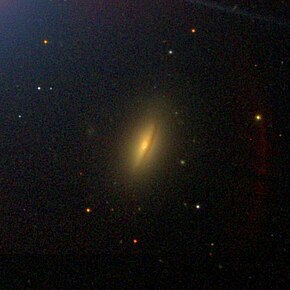
The New General Catalogue of Nebulae and Clusters of Stars is an astronomical catalogue of deep-sky objects compiled by John Louis Emil Dreyer in 1888. The NGC contains 7,840 objects, including galaxies, star clusters and emission nebulae. Dreyer published two supplements to the NGC in 1895 and 1908, known as the Index Catalogues, describing a further 5,386 astronomical objects. Thousands of these objects are best known by their NGC or IC numbers, which remain in widespread use.

Hydra is the largest of the 88 modern constellations, measuring 1303 square degrees, and also the longest at over 100 degrees. Its southern end borders Libra and Centaurus and its northern end borders Cancer. It was included among the 48 constellations listed by the 2nd century astronomer Ptolemy. Commonly represented as a water snake, it straddles the celestial equator.
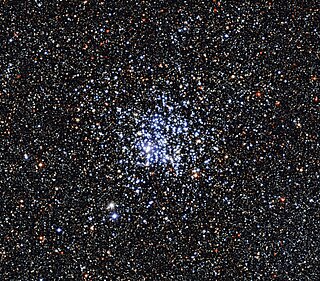
The Wild Duck Cluster is an open cluster of stars in the constellation Scutum. It was discovered by Gottfried Kirch in 1681. Charles Messier included it in his catalogue of diffuse objects in 1764. Its popular name derives from the brighter stars forming a triangle which could resemble a flying flock of ducks. The cluster is located just to the east of the Scutum Star Cloud midpoint.

NGC 206 is a bright star cloud in the Andromeda Galaxy, and the brightest star cloud in Andromeda when viewed from Earth.

The Sculptor Dwarf Irregular Galaxy (SDIG) is an irregular galaxy in the constellation Sculptor. It is a member of the NGC 7793 subgroup of the Sculptor Group. The galaxy was discovered in 1976.
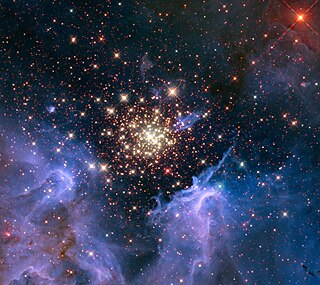
Sher 25 is a blue supergiant star in the constellation Carina, located approximately 25,000 light years from the Sun in the H II region NGC 3603 of the Milky Way. It is a spectral type B1Iab star with an apparent magnitude of 12.2. Its initial main sequence mass is calculated at 60 times the mass of the Sun, but a star of this type will have already lost a substantial fraction of that mass. It is unclear whether Sher 25 has been through a red supergiant phase or has just evolved from the main sequence, so the current mass is very uncertain.
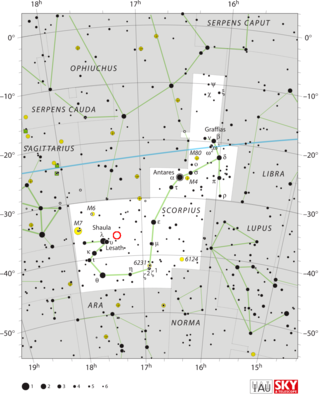
NGC 6334, colloquially known as the Cat's Paw Nebula, or Gum 64, is an emission nebula and star-forming region located in the constellation Scorpius. NGC 6334 was discovered by astronomer John Herschel in 1837, who observed it from the Cape of Good Hope in South Africa. The nebula is located in the Carina–Sagittarius Arm of the Milky Way, at a distance of approximately 5.5 kilolight-years from the Sun.

NGC 2867 is an elliptical Type II planetary nebula in the southern constellation of Carina, just over a degree to the NNW of the star Iota Carinae. It was discovered by John Herschel on April 1, 1834. Herschel initially thought he might have found a new planet, but on the following night he checked again and discovered it had not moved. The nebula is located at a distance of 7,270 light-years from the Sun.

NGC 1579 is a diffuse nebula located in the constellation of Perseus. It is referred to as the Northern Trifid because of its similar appearance to the Trifid Nebula, which is located in the southern celestial hemisphere of the sky. It is a H II region, a region of star formation.

NGC 1903 is a star cluster in the Large Magellanic Cloud in the constellation Dorado. It was discovered in 1834 by John Herschel with an 18.7-inch reflecting telescope.

NGC 121 is a globular cluster of stars in the southern constellation of Tucana. It is the oldest globular cluster in the Small Magellanic Cloud (SMC), which is a dwarf satellite galaxy of the Milky Way. This cluster was first discovered by English astronomer John Herschel on September 20, 1835. The compiler of the New General Catalogue, Danish astronomer John Louis Emil Dreyer, described this object as "pretty bright, pretty small, little extended, very gradually brighter middle". The cluster is located at a distance of around 200,000 light-years (60 kpc) from the Sun.
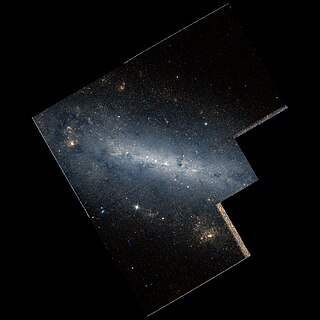
NGC 672 is a spiral galaxy in the northern constellation of Triangulum, positioned around 2° to the southwest of the star Alpha Trianguli. The original object designated NGC 672 was discovered by the German-born astronomer William Herschel on 26 October 1786, but this was later cataloged as NGC 614. The object now identified as NGC 672 was discovered by John Herschel on 11 November 1827.

NGC 6905, also known as the Blue Flash Nebula, is a planetary nebula in the constellation Delphinus. It was discovered by William Herschel in 1784. The central star is 14.0 mag. The distance of the nebula, as with most planetary nebulae, is not well determined and estimates range between 1.7 and 2.6 kpc.

NGC 156 is a double star located in the Cetus constellation. It was discovered on 1882 by Ernst Wilhelm Leberecht Tempel.

NGC 4424 is a spiral galaxy located in the equatorial constellation of Virgo. It was discovered February 27, 1865 by German astronomer Heinrich Louis d'Arrest. This galaxy is located at a distance of 13.5 million light years and is receding with a heliocentric radial velocity of 442 km/s. It has a morphological class of SB(s)a, which normally indicates a spiral galaxy with a barred structure (SB), no inner ring feature (s), and tightly-wound spiral arms (a). The galactic plane is inclined at an angle of 62° to the line of sight from the Earth. It is a likely member of the Virgo Cluster of galaxies.

NGC 4993 is a lenticular galaxy located about 140 million light-years away in the constellation Hydra. It was discovered on 26 March 1789 by William Herschel and is a member of the NGC 4993 Group.
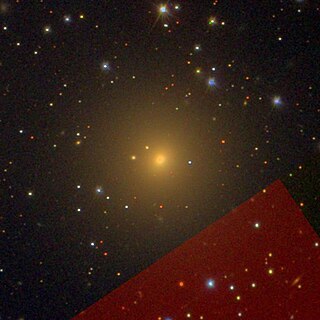
NGC 1272 is a massive elliptical galaxy located about 230 million light-years away in the constellation Perseus. It was discovered by astronomer Heinrich d'Arrest on February 14, 1863. NGC 1272 has an active nucleus and is the second brightest member of the Perseus Cluster after NGC 1275.
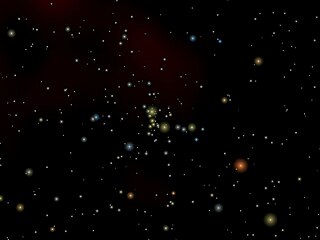
NGC 6910 is an open cluster in the constellation Cygnus. It was discovered by William Herschel on October 17, 1786. The cluster was also observed by John Herschel on September 18, 1828. It is a poor cluster with prominent central concentration and Trumpler class I2p. NGC 6910 is the core cluster of the stellar association Cygnus OB9.

NGC 691 is an unbarred spiral galaxy located in the constellation Aries. It is located at a distance of circa 120 million light years from Earth, which, given its apparent dimensions, means that NGC 691 is about 130,000 light years across. It was discovered by William Herschel on November 13, 1786.

NGC 694 is a spiral galaxy approximately 136 million light-years away from Earth in the constellation of Aries. It was discovered by German astronomer Heinrich Louis d'Arrest on December 2, 1861 with the 11-inch refractor at Copenhagen.
